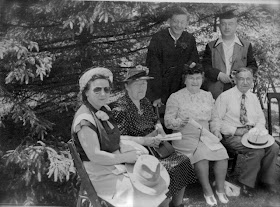 |
| Casimir Zdrojewski processes at his graduation ceremony. Which graduation is this? What is the year? What does D. O. M. stand for? Would those who know please post a comment and clue us in? |
 |
| Congratulations, Cazu. |
 |
| Standing: Casimir (handsome lad!), his father John. Seated: Eleanor, Grandma Victoria, Who, please?, and Who, Please? |

This is from Casey's high school graduation from St. John Kanty Preparatory in Erie, Pa. (St. John Cantius was a medieval Polish theologian and philosopher, sometimes considered eastern Europe's Thomas Aquinas)
ReplyDeleteD.O.M. is the abbreviation for the Latin, Deo Optimo Maximo (to God, the best, the greatest).
The gentleman in the tie, and the lady in the foreground of the standing picture are Joseph and Louise Kotwas, Eleanor's parents and my maternal grandparents. Joseph came to Buffalo via Brooklyn from Russian Poland (those damned partitions again) in 1902, alone and with $5. Louise was born in the United States, her father, (and maybe mother also) George Chmielewski having come here in the 1870's! This was even before St. Stanislaus Church, the first Polish parish in the Catholic diocese of Buffalo had been established. Up to that time, the Poles worshipped at St. Mary's Church on Broadway and Pine,a German parish. George bought ten of the first burial plots at St. Stanislaus Old Cemetery, second row from the street, and I still remember visiting and caring for them periodically.
There is a link between St. John Kanty Prep and Niagara University, the subject of a previous post. They, although the former is no longer operating, were both established and operated by the men's religious order of priests and brothers formally known as the Congregation of the Mission (informally known as the Vincentians, being founded by St. Vincent dePaul, a 16th century Parisian priest).
Now an ecclesioethnic tidbit. Niagara is within the Eastern Province of the Order, while St. John Kanty was in the New England province. The Vincentians were a prominent religious order in Poland. When they arrived here in significant numbers and saw the power distribution based on ethnicity in the American Catholic Church, they insisted on their own province. And ironically , Kanty of the Polish New England Province was geographically in the Irish Eastern Province. This probably annoyed more than a few collared Irishmen! But think about it--- Erie was a reasonable geographic center for a Polish prep school, midway between the Polish population centers of New England, Buffalo, Pittsburgh, Cleveland,Detroit, and Chicago.
Thanks for this, John. By this:
ReplyDelete"Joseph came to Buffalo via Brooklyn from Russian Poland (those damned partitions again) in 1902, alone and with $5."
the Kotwas family outdoes the family in "My Big Fat Greek Wedding." Their Dad had $8.
Okay, wait.
ReplyDelete"Niagara is within the Eastern Province of the Order, while St. John Kanty was in the New England province."
Eire, PA, site of St. John Kanty Prep, is SOUTH of Niagara Falls, maybe a little southwest. Who on earth put Erie in a New England province, and Niagara in "the East?' Is this a sad instance of Poles looking skyward like Copernicus, and getting mixed up when they returned their gaze to Earth? Perish the thought.
Maybe it was an intentional incursion into Irish religious territory: an ecclesiasticopolitical move!
John writes further:
ReplyDelete"Your last sentence nailed it. Geographically, Erie was in the Eastern Province but St. John Kanty,as an institution, although geographically in the Eastern Province was canonically in the New England province So, the Polish Vincentians of the New England Province could be considered to have invaded the geographic turf of the Irish Eastern Province. They also developed some Polish parishes on the Irish turf also, notably in Utica. So more clerically collared red faces among the descendants of Eire."
To which I can only say: Red faces are better than battles.
Julie